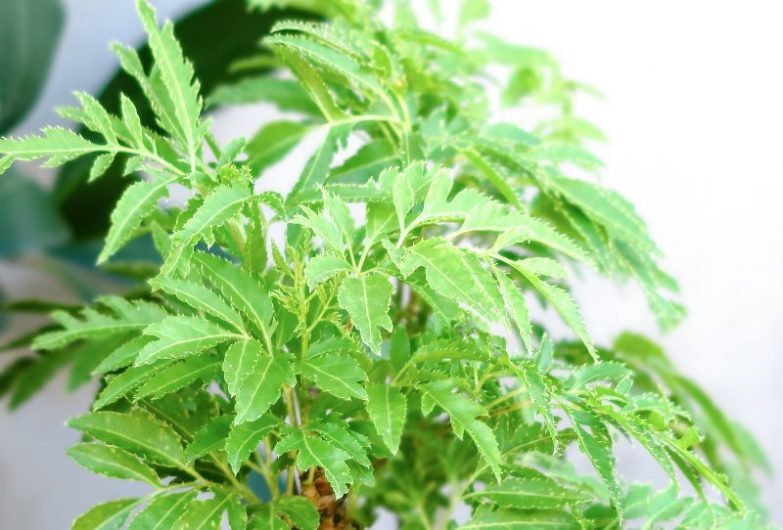The Ming Aralia (Polyscias fruticosa) is a former favorite that has fallen out of popularity in recent decades, but it deserves a comeback! Although it’s not a beginner’s plant, it’s not hard to satisfy indoors. Let’s review everything you need to know about Ming Aralia care so you can enjoy this underrated beauty.
The Ming Aralia likes bright indirect light and moist, well-draining soil. Provide high humidity, temperatures of 65-85°F (18-29°C), and fertilize 3 times per year. It benefits from pruning and shaping. It is moderately disease and pest resistant but will drop leaves after a move or other stress.
Overview Of The Ming Aralia
The Ming Aralia (Polyscias fruticosa) is an evergreen perennial member of the Araliaceae family. Sometimes called the Chinese Aralia, it is native to forest floors in South Asia and surrounding Pacific islands.
The plant’s luxuriant, variable foliage and distinctive gnarled trunk give it an exotic look, but the plant adapts well to indoor living.
The Ming Aralia was quite popular for over a century, but it has faded from view in recent years. According to industry professionals, the problem was forced growth techniques by nurseries eager to capitalize on market demand.
The pumped-up plants would “shatter,” or lose all their leaves, shortly after being sold. Mings acquired the reputation for being difficult – and sales plummeted.
The future looks brighter as dedicated sellers are reviving interest by releasing healthy stock. Leaf loss in response to change or poor conditions is still a feature of the plant, to be sure, but a healthy, well-raised plant is more resilient and rebounds much more quickly.
The Ming Aralia has unusual fern-like fronds with a feathery texture and saw-toothed edges, but that’s only part of its charm. The stems are twisted and exposed beneath the canopy, presenting an eye-catching layered effect either alone or in harmonious contrast with large-leaved plants.
Each Ming Aralia is unique and can be sculpted into a stunning display whether as a desk plant or a seven-foot-tall centerpiece. An excellent bonsai specimen, it’s a slow-growing, long-lived plant that can be handed down to multiple generations.
Though the Ming Aralia has specific requirements, they are easy to provide indoors. Once acclimated, the plant can adapt to a variety of light and humidity levels. It sheds leaves both cyclically and in response to environmental conditions, but the foliage does regrow.
Ming Aralia Care Summary
| Scientific Name | Polyscias fruticosa |
| Origin | Southeast Asia |
| Light Requirements | Bright, indirect light. Can adapt to tolerate some direct sunlight. |
| Watering | Let the top inch of soil dry before watering. Prone to root rot, so take care not to leave soil soggy. |
| Soil | Light, well-draining soil. 1/3 potting mix, peat or coco-coir, 1/3 perlite or coarse sand, and 1/3 aged compost is a good option. |
| Temperature | 65ºF (18ºC) to 85°F (29°C). Goes dormant below 60ºF (15ºC). |
| Fertilizer | Apply a balanced fertilizer approximately 3 times per year during the growing season. |
| Humidity | Moderate to high humidity. Aim for at least 50% humidity. |
| Flowering | Produce small white or yellow blooms in summer when grown outdoors. Very unlikely to flower indoors. |
| Pruning | Responds well to regular pruning. Vertical growth should be pruned to promote bushier growth. Ming Aralia make wonderful bonsai trees. |
| Propagation | Propagate from stem cuttings in spring or summer. |
| Re-Potting | Avoid repotting too often. Once every 2-3 years is plenty, and should only be done when showing signs of becoming rootbound. |
| Diseases and Pests | Quite resistant to pests and disease. Most likely to suffer from spider mites. |
| Toxicity | Mildly poisonous to humans and animals. |
| Where To Buy | Buy Ming Aralia online at Etsy (I buy most of my houseplants from Etsy). |
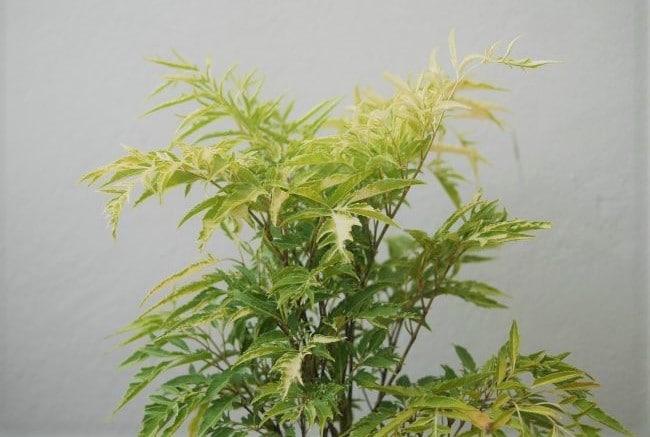
Ming Aralia Light Requirements
Ming Aralias prefer moderate indirect light; they can, however, acclimate to both gentle sun when outdoors or lower light inside. Be aware that a loss of older leaves will occur as the plant adjusts to new light levels.
The plant can live for many years in low light, but they grow faster and more compactly in bright, indirect light. They can become leggy, thin, and pale if the light is too dim. One simple measure is to keep them in light bright enough to read by.
Note: Ming Aralias consume more water in bright light, and their needs are more regular and easier to evaluate. They are much easier to overwater in low-light conditions.
Your Ming Aralia will enjoy being outdoors through the warm season if placed in light shade or filtered sun. They can adapt to mild full sun if it’s not too strong, but let them acclimate slowly.
They are likely to lose leaves both when being put outside and when brought in for winter, but the outdoor vacation can boost growth enough to make up the difference. It may help grow stronger, thicker trunks too.
Good Office Plant
Ming Aralias also do well under the fluorescent lighting of a typical office environment. They appreciate the steady, regular illumination.
Another bonus is that the plant doesn’t grow quickly in normal office lighting. This makes them low maintenance as far as pruning and repotting are concerned – and they complement the formal design of an office, too.
How To Water Ming Aralia
One of the areas of Ming Aralia care that is essential to get right is watering, as they can be a little touchy, especially if they are not yet well-established. They like moisture around their roots but are vulnerable to root rot. Always check the soil before watering – don’t just water them according to a schedule.
The “good” news is that Ming Aralias alert you by shedding leaves quickly if their watering routine is poor. If you’re not sure whether the problem is too much or too little water, keep them on the drier side. They can survive a minor drought, but root rot is deadly.
Some growers recommend keeping the soil moist, but realize this advice may be for a plant growing in bright light with a lot of humidity and warmth. In lesser conditions, it’s better to let the surface dry out a bit more between waterings to ensure the roots can breathe.
Here are other tips:
- Let the top inch of soil dry before rewatering, but never let the rootball dry completely. Use a wooden chopstick or similar item to probe the soil, and check the tip for dampness.
- If you’re growing in a peaty mix, it can be a good idea to water two times, five minutes apart. It takes extra effort to remoisten dried peat.
- Water thoroughly and let the excess drain to flush the soil.
- Reduce watering over the cool months, but don’t let the soil become bone dry.
- Ming Aralias can be sensitive to alkaline or highly mineralized water. If you see white deposits on the foliage, switch to using rainwater or another purified source.
- Read my article on how to water houseplants for some great tips on perfecting this aspect of care.
Ming Aralia Soil Requirements
As long as the soil is light and well-draining, Ming Aralias are not too particular. They like a slightly acidic medium with an approximate pH of 6.0 to 6.5, so organic material is a suitable element for their mix.
A popular Ming recipe is to combine water-retaining peat moss or coco coir and inorganic materials like perlite, pumice, or coarse sand. These components make it possible to soak the soil and have it drain immediately, so the plant’s modest root system remains oxygenated and never “drowns.”
One good combination is a third each of peat moss, an inorganic aeration material, and humus, aged compost or potting soil. Read my article on making and choosing houseplant soil for more information.
Prefers High Humidity
Though Ming Aralias are technically a high-humidity plant, you can find differing opinions about how high. Some growers would banish the plant to a greenhouse, but others find normal humidity is fine if the watering is correct.
Both opinions may be right, according to personal experience. Growers that struggled through the era of forced Ming Aralias will naturally have a different opinion than gardeners who’ve dealt with healthier specimens.
The best advice is to observe your own plant and take steps as needed. The signs of a plant suffering from low humidity are dried leaves and lackluster growth. Very dry air can also cause leaf loss.
What is certain is that the plant welcomes higher humidity. Short of a room humidifier or an actual greenhouse, there are a few humidity-raising methods to try.
- Placing water trays near or under the plant can raise humidity a few points. Use pebbles to keep the plant’s container above the waterline.
- Grouping plants can also modestly boost humidity. Plants give off water vapor in small amounts, which can create a more humid microclimate.
- Misting is too transient to make a difference, but a brisk shower can give plants a humidity lift and wash dust and pests from their leaves.
- Placing the plant in humid spots can help, provided that light and other conditions are sufficient. Bright laundry rooms and bathrooms are potentially suitable.
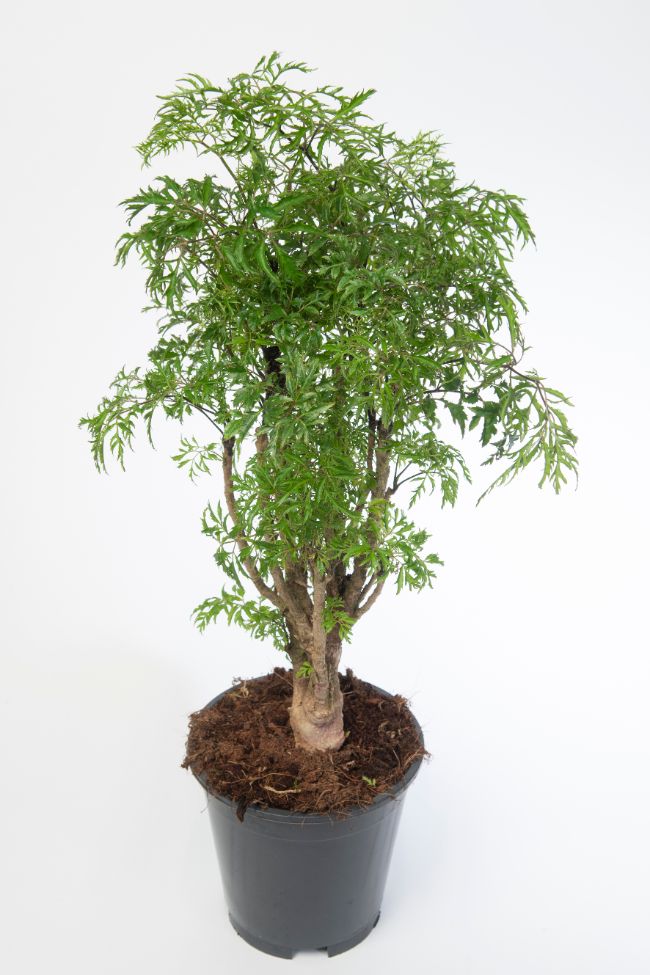
Warm Temperatures
Ming Aralias do great in normal indoor temperatures. They prefer a range from 65ºF (18ºC) to 85°F (29°C).
The plant goes dormant below 60ºF (15ºC) and will suffer if it gets much colder: Goodbye leaves!
The plant does well outdoors in USDA Zones 10 to 12.
How To Fertilize Ming Aralia
The Ming Aralia needs only light fertilization through the warm growing season. If your plant is in low light or cool temperatures, adjust the amount downward. Overfeeding problems are more common than nutritional deficiencies.
The usual signs of undernutrition are lackluster growth and pale or yellow-green new foliage. Make modest corrections and don’t overfeed the plant to “stimulate” it.
Unused fertilizer builds up in soil if you don’t flush the mix regularly. The Ming’s small root system is easily overwhelmed with toxic residue and can show up in – you guessed it – leaf loss. Brown tips and edges are other classic signs of fertilizer burn.
One recommended regimen is to fertilize three times a year: spring, summer, and fall. Don’t feed the plant over the winter.
A balanced formula with an NPK ratio of 10-10-10 or similar proportion is suitable, but only use half the amount indicated on the label. I’ve written an article covering all aspects of fertilizing houseplants which you may find helpful.
Flowering
Outdoor plants in the tropics produce summertime clusters of small white or yellow flowers, but Ming Aralias seldom bloom in containers or indoors. So … let’s move on.
Pruning
Regular pruning is an important part of providing good Ming Aralia care and keeping your plant looking its best. The plant grows vertically and must be encouraged to grow outwards. Pruning allows you to keep the plant at a desirable size and shape.
Trimming your Ming can be an artform, literally: the plant responds well to classic bonsai techniques. With careful pruning, the naturally crooked-stems can be trained into a complex layered structure with textured branches and dense areas of foliage. It can become a real showpiece.
Tips:
- To avoid shocking an active plant, trim it during the cooler months.
- Trim the top to limit vertical growth. This also helps promote dense growth.
- Trim new growth to promote branching.
- When you shorten a branch, it usually forks from that point.
- Cutting stem tips helps stimulate thickening of the trunk and branches.
- Pruning the end of a branch causes future stems to grow closer and produce a zigzag pattern.
- Pruning doesn’t disturb the plant as much as repotting or relocating, so you can trim a plant that is sparse or struggling. It can even help rejuvenate them.
Growing A Ming Aralia Bonsai
Ming Aralias are suitable for bonsai, but its branches are too soft to be wired without damage. Instead, prune the plant slightly every two months.
Trim the inner branches for a more tree-like look. Cutting stems with multiple leaves back to just two will leave a more open structure.
Keep the suckers trimmed off to help the trunk grow thicker.
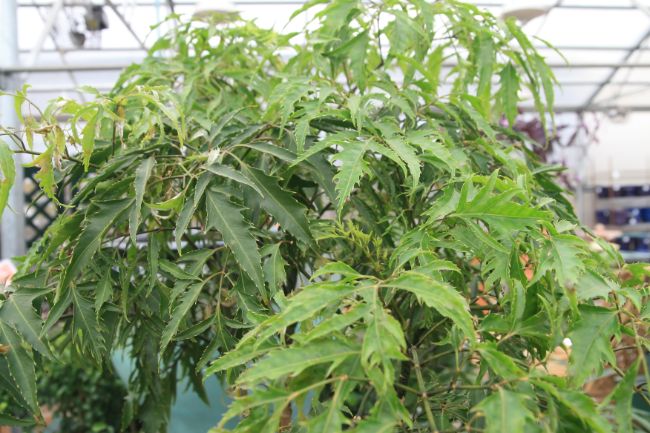
Repotting
Mings don’t need frequent repotting. This is good, because repotting is another occasion to drop leaves! The foliage will recover, however, with proper care.
The plant doesn’t mind being a little rootbound, so let the container fill with roots before repotting. The root system is rather small: every two or three years is a typical interval for mature specimens. The plant generally stays smaller if you repot less often.
Note: Mings have been known to thrive for years in the same pot. This can exhaust the soil over time; if you’re not repotting, it’s still best to partially refresh the soil each year.
- Spring is the best time to repot.
- Evaluate whether it’s time to repot by checking the root system. Wait until the soil is almost dry and gently unpot the plant. The roots should be light-colored and smell like earth. If the rootball fills the pot and larger roots are circling the bottom, it’s <em>go time</em>.
- In bonsai fashion, Ming Aralias can live in a pot that seems comparatively small in relation to its size. However, deeper pots are generally preferable to shallow ones.
- When repotting a root bound plant, only go up one container size. The Ming’s roots are rather fine and don’t spread widely. Remove loose soil and replace it with a similar medium.
- After repotting, water thoroughly to saturate both old and new soil.
- If you decide to prune the roots to keep the plant’s container the same size, consider lowering their temperature to induce dormancy about three weeks before repotting. Afterwards, immediately warm them back to over 65ºF (18ºC) to jump start root growth.
Propagation
It’s not too difficult to propagate Ming Aralias with stem cuttings. The time to take cuttings is late spring or early summer – they won’t root during winter dormancy.
Here are the steps:
- Take a four- to six-inch cutting from the top of the plant. Young growth is best. Don’t cut the stem below its lowest leaf: the whole branch may die.
- Remove all but the top leaf or two from your chosen stem. Some suggest waiting 24 hours afterwards. Then cut just below a leaf node, trimming at a 45º angle to maximize the growing surface.
- Dip the end in rooting hormone and insert it into sterile, moist potting mix. One method is to place four or five cuttings together in a four- or five-inch pot.
- Keep the cuttings warm, above 72ºF (22ºC). Higher temperatures are even more effective.
- Give them indirect light that isn’t intense. They’ll root in low-to-medium light.
- To optimize humidity, cover with a plastic bag. Monitor the soil and don’t overwater. You can mist the plant, but not heavily.
- Cuttings typically grow roots in four to five weeks, though it can happen sooner. Once the cutting has a small root system, remove the plastic cover (and stop misting).
Ming Aralia Care Tips
- Good air circulation is important.
- Old leaves cannot adapt to changes in light, which is why they drop off after a move. If you must relocate a plant, it makes sense to do it after a pruning, when there are fewer old leaves to lose.
- Loss of foliage from lower stems is inevitable as the plant matures; but, take heart. It creates an attractively textured surface on the bare trunks.
- Keep the plant in warm, humid air over the winter to avoid drastic shedding. A plant in cold, dry air quickly becomes bare.
- Moving plants outside in the growing season can be beneficial, even though you can expect foliage loss after each move. Being outdoors can stimulate greater growth overall.
- Avoid purchasing a forced plant! Signs of forcing are light-colored, thin leaves that are discolored and/or deformed, spindly stems with widely spaced joints, and a weak root system.
Toxicity
Though Ming Aralias have a long history of use in traditional Asian medicine, they are mildly poisonous to humans and pets. The plant has Level #2 toxicity and can cause nausea, digestive disturbance, and vomiting.
The plant’s sap may also cause skin irritation, so wear gloves for protection.
Varieties
The Ming Aralia’s Araliaceae family also includes English Ivy and Ginseng. Their Polyscias genus inhabits warm climates in Southeast Asia and surrounding islands. There are about 116 listed Polyscias species.
The Ming Aralia has a few varieties and/or cultivars, and all variations should receive the same treatment.
Here are common ones:
Snowflake Ming – This is a medium-sized variegated form of the main plant. Its leaves feature a snowflake pattern.
Plumata – The foliage of the Plumata is feathery and small. It’s especially suited for bonsai; it may be a form rather than a unique variety.
Chunky Dwarf – Though retailed as a cultivar, this may simply be a plant pruned and grown to assume a dwarf shape.
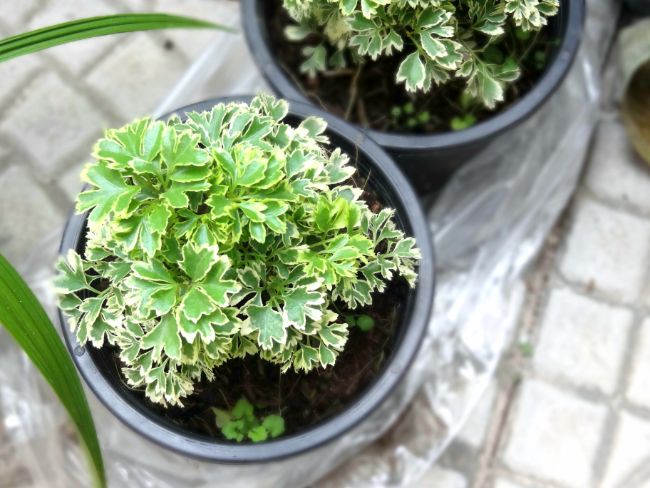
Pests And Diseases
A healthy, unstressed Ming isn’t particularly susceptible to pests or disease. If you find an infestation, it could be the sign of another problem.
Spider mites are an exception. If the humidity is low, these pests can multiply under the plant’s leaves unnoticed. It’s best to use a gentle treatment like a horticultural oil or insecticidal soap to eradicate them. Read more about identifying and getting rid of Spider mites.
Common Ming Aralia Care Problems
Yellowing Leaves
Yellowing leaves are a common signal of overwatering, so review your routine. If you’re unsure and the plant isn’t too large, unpot it and check the soil.
If the yellowing is gradual and you haven’t repotted in a while, the soil may starting to deplete. Don’t dramatically increase fertilization, but be sure to follow the recommended routine … and repot next spring!
Leaf Drop
Modest leaf drop from lower branches can occur naturally a few times a year … if there is healthy new growth happening on top, it’s probably nothing to worry about.
Excessive leaf drop is the most common problem with Ming Aralia care. There are two main manifestations of leaf drop:
Relocation – If your plant has recently been relocated and is showering leaves, it’s still probably not a cause for concern. Unfortunately, that’s what this plant does when you move it.
While other environmental conditions do matter, lighting changes are the main trigger. Old leaves die and are replaced. It’s a bit of a bummer but completely normal for this plant. Give them good care and be patient: new replacement growth should appear soon.
Inadequate Conditions – If a plant has lived happily in one spot for some time and it suddenly starts to lose leaves, investigate further. Leaf loss can be the Ming’s early warning signal:
Here are common causes:
- Low Humidity – Dry air can push a Ming to protest conditions it would otherwise take in stride.
- Watering Issues – Drought can cause stress and leaf loss … but overwatering is worse. Don’t overcompensate for a dry spell with extra watering, just return to correct care.
- Depleted soil – If the plant has been in one pot for many years, consider refreshing the soil or repotting.
- Salt Residue – Old fertilizer and other residues can accumulate and toxify the soil. Flush the mix thoroughly and regularly.

